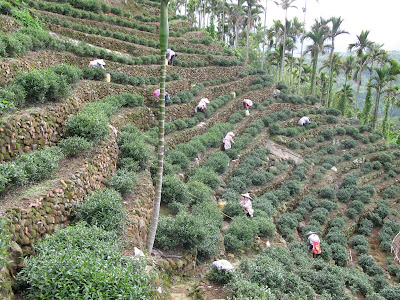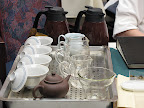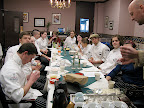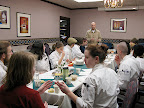
Friday, May 23, 2008
Thursday, May 22, 2008
Gong Fu Tea by Master Luo
My Question: "How should I prepare Mu Za Iron Goddess?"
Master Luo's response: "Mu Za Iron Goddess should be prepared similarly to a high mountain oolong. First heat you tea pot, then fill the pot 1/4 full with loose leaf tea. There is no need to rinse the leaves. For the first infusion, use boiling water and infuse for 10 seconds. This first infusion will be very light, but it will prepare the pallet and the senses for what is to come. Also, if there is any residual scent or flavor left on your pallet, this first infusion will wash that away. For each consecutive infusion, do the same... boil the water and infuse for 10 seconds. This way of brewing the tea will yield about ten infusions and each will be extremely aromatic and full of flavor."
This is one way to make tea that I have been playing with. I have been enjoying the results, but find that one of the most important considerations is to make sure that the water is hot hot hot, right off the boil.
Master Luo's response: "Mu Za Iron Goddess should be prepared similarly to a high mountain oolong. First heat you tea pot, then fill the pot 1/4 full with loose leaf tea. There is no need to rinse the leaves. For the first infusion, use boiling water and infuse for 10 seconds. This first infusion will be very light, but it will prepare the pallet and the senses for what is to come. Also, if there is any residual scent or flavor left on your pallet, this first infusion will wash that away. For each consecutive infusion, do the same... boil the water and infuse for 10 seconds. This way of brewing the tea will yield about ten infusions and each will be extremely aromatic and full of flavor."
This is one way to make tea that I have been playing with. I have been enjoying the results, but find that one of the most important considerations is to make sure that the water is hot hot hot, right off the boil.
Back from Taiwan
It is great to be back in the Tea shop. I am here, but I left my cell phone in Taiwan. If you need to call, please call 503-922-1555. The tea is on the way and should be here within two weeks. What do you have to look forward to? Here is the list of new tea that is on the way:
These are the green oolongs
Spring Harvest 2008 Four Seasons oolong
Spring Harvest 2008 Jin Xuan
Spring Harvest 2008 Bamboo Mountain Oolong
Spring Harvest 2008 Zhang Shu Hu Oolong
Spring Harvest 2008 Shan Lin Xi Superior High Mountain Oolong
For eastern beauty I found
Summer Harvest 2007 Formosa Oolong
I have some great Iron Goddess on the way
Winter Harvest 2007 Mu Za Iron Goddess Honorable Mention
Winter Harvest 2008 Mu Za Iron Goddess First Tier
Puer
Some cooked puer is coming this way and I also have about six different big tree puer cakes to share. The leaves are green and the tea is strong, but the prices are more reasonable than ever.
There are many other teas as well. The new web site is almost here. Prices will be reduced when buying in 1/4 pound and greater quantities. I hope that people will take advantage of the savings and buy in 1/4 pound sizes and greater, so that the wonderful world of tea can be enjoyed every day by more and more tea fans.
I learned so much on this trip and met so many fascinating people. Now it is time to get to work so that I can share all of the information that I absorbed.
These are the green oolongs
Spring Harvest 2008 Four Seasons oolong
Spring Harvest 2008 Jin Xuan
Spring Harvest 2008 Bamboo Mountain Oolong
Spring Harvest 2008 Zhang Shu Hu Oolong
Spring Harvest 2008 Shan Lin Xi Superior High Mountain Oolong
For eastern beauty I found
Summer Harvest 2007 Formosa Oolong
I have some great Iron Goddess on the way
Winter Harvest 2007 Mu Za Iron Goddess Honorable Mention
Winter Harvest 2008 Mu Za Iron Goddess First Tier
Puer
Some cooked puer is coming this way and I also have about six different big tree puer cakes to share. The leaves are green and the tea is strong, but the prices are more reasonable than ever.
There are many other teas as well. The new web site is almost here. Prices will be reduced when buying in 1/4 pound and greater quantities. I hope that people will take advantage of the savings and buy in 1/4 pound sizes and greater, so that the wonderful world of tea can be enjoyed every day by more and more tea fans.
I learned so much on this trip and met so many fascinating people. Now it is time to get to work so that I can share all of the information that I absorbed.
Friday, May 02, 2008
Harvest Time April 28th 2008
A new tea set
 I bought this tea set in Lugu because when using this teapot heavily baked oolongs such as Dong Ding oolong and Iron Goddess oolong will taste even better than they usually do. The pot's clay is very pourous and it will aid in creating an overall softer sensation to the highly baked oolongs. I look forward to using this set to make tea for guests in the shop for years to come.
I bought this tea set in Lugu because when using this teapot heavily baked oolongs such as Dong Ding oolong and Iron Goddess oolong will taste even better than they usually do. The pot's clay is very pourous and it will aid in creating an overall softer sensation to the highly baked oolongs. I look forward to using this set to make tea for guests in the shop for years to come.
Tea! Love at first sight.
 April 28th
April 28thToday I as I enter the village of Ming Jian I immediately see tea fields of tea on both sides of the road. This is very exciting! The scent of tea fills the air and I practically launch out of the car window as we encounter some of the first tea fields on this trip. As we steadily gain elevation, I begin to salivate anticipation of the wonderful teas to come.
Giant Teapot
Thursday, May 01, 2008
Spring Tea Shopping
April 26th 2008
I arrived at Tao Yuan International airport and got my luggage. One of my bags was called out for inspection, and as you would have guessed if you knew me well, it was the bag full of tea. Why bring a suitcase full of tea to Taiwan you might ask and rightly so. I am bringing the tea back to Taiwan so that I can bake it. This will revitalize the tea. It will bring back a fresh flavor and give it a liveliness that is so wonderful in oolongs. The customs officer let me know that there is a limit to the amount of oolong tea that one can bring into Taiwan. The limit is one kilo and I had about twenty kilos of tea. I explained that this was all tea that I brought from Taiwan and luckily he let me bring the tea in, but explained that I would have to bring proof that this tea was exported from Taiwan if I was planning to do this again. I thanked him and headed for the bus that would take me to the high speed rail.
My train left at 8:20 pm and I arrived in Jia Yi (Chiayi) one hour later. Wow that was fast. My teacher met me at the Jia Yi train station and after stopping for a snack we immediately went to a tea farmer’s house. I asked him to show me the teas that are recent harvests. He gladly obliged by picking out three teas, but he wanted to give me a test. He weighed five grams of each and steeped them for three minutes each in separate professional tasting sets. Our mission was to tell him how the teas should be ranked according to taste from most expensive to least. Price is used as a measure because where taste is subjective, price is not. The higher the price usually means the higher the elevation at which the tea was grown.
I didn’t want to be influenced by the others tasting, so I knew I had to be fast. After smelling the leaves I cast my vote. Without even tasting the tea I had made my decision, and then I went onto to taste just to make sure. My teacher agreed with me, so I felt confident, but the other taster disagreed. As luck would have it, I was right.
I placed my order and within two hours of being in Taiwan I was in possession of 115 pounds of tea. You’ve got to love Taiwan!
I arrived at Tao Yuan International airport and got my luggage. One of my bags was called out for inspection, and as you would have guessed if you knew me well, it was the bag full of tea. Why bring a suitcase full of tea to Taiwan you might ask and rightly so. I am bringing the tea back to Taiwan so that I can bake it. This will revitalize the tea. It will bring back a fresh flavor and give it a liveliness that is so wonderful in oolongs. The customs officer let me know that there is a limit to the amount of oolong tea that one can bring into Taiwan. The limit is one kilo and I had about twenty kilos of tea. I explained that this was all tea that I brought from Taiwan and luckily he let me bring the tea in, but explained that I would have to bring proof that this tea was exported from Taiwan if I was planning to do this again. I thanked him and headed for the bus that would take me to the high speed rail.
My train left at 8:20 pm and I arrived in Jia Yi (Chiayi) one hour later. Wow that was fast. My teacher met me at the Jia Yi train station and after stopping for a snack we immediately went to a tea farmer’s house. I asked him to show me the teas that are recent harvests. He gladly obliged by picking out three teas, but he wanted to give me a test. He weighed five grams of each and steeped them for three minutes each in separate professional tasting sets. Our mission was to tell him how the teas should be ranked according to taste from most expensive to least. Price is used as a measure because where taste is subjective, price is not. The higher the price usually means the higher the elevation at which the tea was grown.
I didn’t want to be influenced by the others tasting, so I knew I had to be fast. After smelling the leaves I cast my vote. Without even tasting the tea I had made my decision, and then I went onto to taste just to make sure. My teacher agreed with me, so I felt confident, but the other taster disagreed. As luck would have it, I was right.
I placed my order and within two hours of being in Taiwan I was in possession of 115 pounds of tea. You’ve got to love Taiwan!
Wednesday, April 02, 2008
Gong fu cha; easy as 1, 2, 3....... 6, 7, 8, 9
This is a question that often comes up. Most often, people think that this size pot will only make enough tea for one. This is a guide to the basic outlines of Gong Fu tea brewing, as well as a demonstration to show the amount of tea that a small pot will produce. Just remember, it is not the size of your teapot, but how you use it, that is most important.
 The setup
The setup
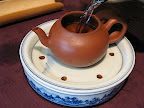 Heating the pot. Fill your pot with boiling hot water and let set for a few moments. One tea master told me that the pot is properly heated only when the lid handle is hot. If you fill your pot with boiling hot water and wait about a minute, then touch the lid handle of the pot, it should be hot. This is a good start.
Heating the pot. Fill your pot with boiling hot water and let set for a few moments. One tea master told me that the pot is properly heated only when the lid handle is hot. If you fill your pot with boiling hot water and wait about a minute, then touch the lid handle of the pot, it should be hot. This is a good start.
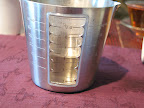 This is a 6 ounce pot.
This is a 6 ounce pot.
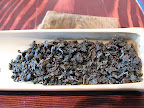 The leaf, compliments of J-Tea. Competition Winner Mu Za Iron Goddess (Second Tier) Spring 2007
The leaf, compliments of J-Tea. Competition Winner Mu Za Iron Goddess (Second Tier) Spring 2007
 15g of tea
15g of tea
 The leaves should fill the pot about 1/3rd of the way.
The leaves should fill the pot about 1/3rd of the way.
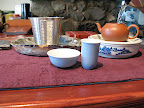 First infusion-30 seconds-no rinse. I typically will not rinse the tea, especially when it is of such a high grade.
First infusion-30 seconds-no rinse. I typically will not rinse the tea, especially when it is of such a high grade.
 The first infusion yields about 5 ounces of mouth watering tea.
The first infusion yields about 5 ounces of mouth watering tea.
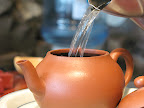 Moving right along to the second infusion-35 seconds
Moving right along to the second infusion-35 seconds
 I love teapots!
I love teapots!
 The first two infusions combined makes just shy of 10 ounces of tea.
The first two infusions combined makes just shy of 10 ounces of tea.
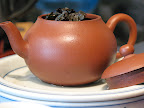 Now the leaves have unfurled and they are expanded enough to just fill up the pot. I think I might have used a tad too much. In general, when the leaves have expanded, they should fill the pot, but they should be fluffy and giving instead of resistant to the touch.
Now the leaves have unfurled and they are expanded enough to just fill up the pot. I think I might have used a tad too much. In general, when the leaves have expanded, they should fill the pot, but they should be fluffy and giving instead of resistant to the touch.
 Third infusion.
Third infusion.
 Pouring water over the top. This action has a number of applications. First, it is fun! Next, it cools the temperature of the pot. It treats the pot adding to the brilliant patina, and it can act as a natural timer. When the pot is again dry, a certain amount of time has gone by. This time will change with pots and with the temperature of the water.
Pouring water over the top. This action has a number of applications. First, it is fun! Next, it cools the temperature of the pot. It treats the pot adding to the brilliant patina, and it can act as a natural timer. When the pot is again dry, a certain amount of time has gone by. This time will change with pots and with the temperature of the water.
 The third and fourth infusion combine to yield just over 8 ounces of tea.
The third and fourth infusion combine to yield just over 8 ounces of tea.
 The fifth and sixth, the same, and...
The fifth and sixth, the same, and...
 the same for the seventh and eighth
the same for the seventh and eighth
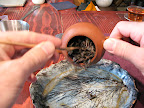 Empty the leaves.
Empty the leaves.


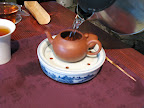 Rinse the pot.
Rinse the pot.
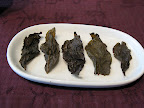 Admire the handiwork.
Admire the handiwork.
Summary:
All in all 15g of dry leaf yielded 34 fluid ounces of tea. Brewing tea in the traditional method according to heavy tea drinkers taste, 1 ounce of tea yields 8 cups of tea. If I were to do this demo again, I would do it with a lesser quantity and quality tea. Quantity, because I actually think I used too much tea as it was poping out of the pot after the first two infusions. Quality, because putting the tea into that measuring cup made it less tasty.
 The setup
The setup Heating the pot. Fill your pot with boiling hot water and let set for a few moments. One tea master told me that the pot is properly heated only when the lid handle is hot. If you fill your pot with boiling hot water and wait about a minute, then touch the lid handle of the pot, it should be hot. This is a good start.
Heating the pot. Fill your pot with boiling hot water and let set for a few moments. One tea master told me that the pot is properly heated only when the lid handle is hot. If you fill your pot with boiling hot water and wait about a minute, then touch the lid handle of the pot, it should be hot. This is a good start. This is a 6 ounce pot.
This is a 6 ounce pot. The leaf, compliments of J-Tea. Competition Winner Mu Za Iron Goddess (Second Tier) Spring 2007
The leaf, compliments of J-Tea. Competition Winner Mu Za Iron Goddess (Second Tier) Spring 2007 15g of tea
15g of tea The leaves should fill the pot about 1/3rd of the way.
The leaves should fill the pot about 1/3rd of the way. First infusion-30 seconds-no rinse. I typically will not rinse the tea, especially when it is of such a high grade.
First infusion-30 seconds-no rinse. I typically will not rinse the tea, especially when it is of such a high grade. The first infusion yields about 5 ounces of mouth watering tea.
The first infusion yields about 5 ounces of mouth watering tea. Moving right along to the second infusion-35 seconds
Moving right along to the second infusion-35 seconds I love teapots!
I love teapots! The first two infusions combined makes just shy of 10 ounces of tea.
The first two infusions combined makes just shy of 10 ounces of tea. Now the leaves have unfurled and they are expanded enough to just fill up the pot. I think I might have used a tad too much. In general, when the leaves have expanded, they should fill the pot, but they should be fluffy and giving instead of resistant to the touch.
Now the leaves have unfurled and they are expanded enough to just fill up the pot. I think I might have used a tad too much. In general, when the leaves have expanded, they should fill the pot, but they should be fluffy and giving instead of resistant to the touch. Third infusion.
Third infusion. Pouring water over the top. This action has a number of applications. First, it is fun! Next, it cools the temperature of the pot. It treats the pot adding to the brilliant patina, and it can act as a natural timer. When the pot is again dry, a certain amount of time has gone by. This time will change with pots and with the temperature of the water.
Pouring water over the top. This action has a number of applications. First, it is fun! Next, it cools the temperature of the pot. It treats the pot adding to the brilliant patina, and it can act as a natural timer. When the pot is again dry, a certain amount of time has gone by. This time will change with pots and with the temperature of the water.  The third and fourth infusion combine to yield just over 8 ounces of tea.
The third and fourth infusion combine to yield just over 8 ounces of tea. The fifth and sixth, the same, and...
The fifth and sixth, the same, and... the same for the seventh and eighth
the same for the seventh and eighth Empty the leaves.
Empty the leaves.

 Rinse the pot.
Rinse the pot. Admire the handiwork.
Admire the handiwork.Summary:
All in all 15g of dry leaf yielded 34 fluid ounces of tea. Brewing tea in the traditional method according to heavy tea drinkers taste, 1 ounce of tea yields 8 cups of tea. If I were to do this demo again, I would do it with a lesser quantity and quality tea. Quantity, because I actually think I used too much tea as it was poping out of the pot after the first two infusions. Quality, because putting the tea into that measuring cup made it less tasty.
Tough Questions
Last weekend I did a tea tasting in Bend, OR. After the tasting, my partner stated that I was only providing about 40% of the information when answering questions. I thought that this was an interesting observation. It also reminded me of my friend in Taiwan that used to ask me, "Have you learned all there is to know about tea yet?" to which I would always answer, "no". Most people think that tea is not complicated, and it is true. Tea is not complicated, but it is not easily understood. Often times, people in my shop will say, "Puer, what is that?" My answer to this question takes about 5 to 15 minutes. There are so many ways to answer this question. My answer usually starts like, "Puer is its own category of tea..."
Tea Tasting at the Lane Community College Culinary Arts program (03/05/08)
Tea is Healthy!
Research conducted at Oregon State University found that freshly brewed tea contains 10 to 100 times more antioxidants than bottled teas. If you want antioxidants, drink freshly brewed tea.
Tea is just as effective as water in helping keep people hydrated. It is a common myth that tea or any other caffeine-containing beverage will cause a loss of body fluid and negatively impact the body's hydration level. Scientific evidence simply does not support this belief. UK experts found that drinking three or more cups of tea a day is as good for you as drinking plenty of water and it even helps to protect against heart disease and some forms of cancer. Drinking tea can give your mind a gentle lift that can help you focus. Moreover, unsweetened brewed tea is a perfect beverage to use as part of a weight management diet or lifestyle.
Tea is just as effective as water in helping keep people hydrated. It is a common myth that tea or any other caffeine-containing beverage will cause a loss of body fluid and negatively impact the body's hydration level. Scientific evidence simply does not support this belief. UK experts found that drinking three or more cups of tea a day is as good for you as drinking plenty of water and it even helps to protect against heart disease and some forms of cancer. Drinking tea can give your mind a gentle lift that can help you focus. Moreover, unsweetened brewed tea is a perfect beverage to use as part of a weight management diet or lifestyle.
Tea demo at the University of Oregon
The professor, Ina Asim, graciously invited me to give a tea demonstration and allow the students to taste several high end oolong teas.
Saturday, March 29, 2008
Dong Ding Gui Fei Mei Ren
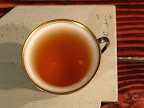
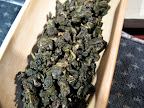

Formosa Oolong
Formosa Oolong is a specific category of oolong also commonly known as “Oriental Beauty”, “Bai Hao Oolong”, “Silver Tipped Oolong”, “Dong Fang Mei Ren”, “Pong Hong Te” and now “Gui Fei Mei Ren”.
How does the Formosa Oolong group get their wonderful flavor? An interesting article in the Taiwanese magazine gives an account:
In the months of May through July tiny insects called leaf hoppers are at their highest concentration. During this time, tea farmers throughout Taiwan make preparations for their summer harvest of Formosa Oolongs. In the past, pesticides were used to discourage these little buggers, but in recent years the farmers have hoped that their crops are well attacked. It was discovered that the more highly concentrated the leaf hoppers, the more flavorful the tea.
The leaf hoppers became a welcome pest, adding flavor to the tea throughout the island. Through several hundred if not thousands of years of evolution, the fresh tea leaf has developed a self defense mechanism. The threat caused by the leaf hopper resulted in abnormal metabolic rhythms being produced by the plant which in turn caused some sort of chemical reaction that results in “multiple tea polyphenols” (the powerful antioxidant found in oolong tea) and tea tannins. These polyphenols and tannins in turn attracted the leukoplakia wax spider, a natural predator of the leaf hopper. A full grown leaf hopper is no bigger than a fruit fly. It is as small as a spec of dust. They have a sharp beak poker mouth that resembles a shortened mosquito snout. The leaf hopper uses this poker to suck out the nutrient juices of the fresh and tender leaves of the camellia sinensis, or tea plant. The leaf hopper threatens the sprout of the fresh leaf which looks like a toothpick. In a controlled experiment, researchers found that when artificially replicating the attack of the leaf hopper in a lab, the tea plant responded similarly, producing the same abnormal metabolic rhythms. But the degree to which the chemical reaction occurred was far less. When researchers tasted both teas the results showed clearly that the tea bitten by the leaf hopper was significantly sweeter than the tea that was artificially attacked. The conclusion of the research was that the classic honey taste associated with Formosa Oolong comes from the leaf hopper actually sucking from the tea sprout.
How did Dong Ding Gui Fei “Leaf Hopper Oolong Tea” come to be? The story begins with an earthquake that occurred in September, 1999, in Nantou, Taiwan, ---7.6 on the Richter scale This earthquake is often referred to as 9-2-1. Nantou County is considered one of the safest natural environments. The island of Taiwan is riddled with earth quakes, but natural Utopias exist. Many moved to Nantou with the idea of being safe. It is an area much like Eugene, a great environment and very close to the mountains. Yet, the epicenter of the devastating earthquake of 9-2-1 was in Nantou. Needless to say, the land was greatly transformed. Many roads were destroyed. There was a period in which the tea fields were unattended to. During this lack of attention, leaf hoppers were abundant. When the reconstruction took place, special care was given to the development and nurturing of the tea farms. As a result of this lack of care followed by some special care, the Dong Ding Gui Fei of 1999 had an exceptional honey taste. Since then Gui Fei has became an immensely flavorful and highly sought after Formosa Oolong.
Subscribe to:
Posts (Atom)




